
In October of 2017 I set out to start building my own private backlink database.
It was always intended to stay private – I don’t have the budget or desire to compete with what’s already out there – and created with my own research purposes in mind.
For instance, I wanted to know what the top sites in specific niches were linking to this year, month, or even week.
Not only would this help with client work, but give me inspiration for content that works well in one niche that might work well in others.
To get this data with current platforms you have to find all the top sites in an industry, crawl through their recent outgoing links – site by site – and then see if you can spot any trends.
It’s a ton of work, and certainly not something I want to do on a regular basis.
If this isn’t your first visit to Detailed then you’ll know that a few weeks ago I shared a large part of my link index in public on our homepage.
Our unique “selling point” (the data will always be free) is that you can easily see popular sites in specific industries and then find the people linking to (and tweeting about) them.
I didn’t want to just show any link or tweet, but mentions from sites that aren’t PBN’s or automated blogs, and tweets from people thought to be ‘influencers’ in their field.
In other words, you can easily find the links that real people are giving out to content they enjoy, rather than scrolling through a ton of spammy mentions.
Now that we’re processing around 100,000 genuine, in-content links per day, I can start pulling out some interesting insights from that data.
I can now see exactly what sites in specific niches (or from the web as a whole) are linking to in certain timeframes.
I’m going to be open up as much of this data as I can in the near future, but for now I thought I would share some of the more interesting content angles that get people talking.
Every single example below has picked up in-content links, in the first three months of this year, from some of the biggest sites in their niche.
If you’re using content marketing as part of an SEO strategy to pick up more links, hopefully this gives you the insights and inspiration you’ve been looking for.
Map Out Your Audiences’ Biggest Goal: A Six-Year-Old Finance Article That Picks Up Links Every Week
Published: Jan 13th, 2012 | Notable link: GetRichSlowly.org (March 15th, 2018)

This example is quite special because it was written over six years ago, yet still has people talking about it like it was just published.
Mr. Money Mustache is one of the biggest names in personal finance, ranking 8th in the world by our count. I’m not surprised to see him picking up links, but I am surprised how well this article is performing compared to his more recent updates.
The piece isn’t particularly long, coming in at “just” 1,100 words, but it is instantly practical and useful for readers of the site.
If you spend a second in the personal finance blogging world, you’ll know a common goal for many in the space is early retirement.
Their focus seems to be less on building businesses like I find in the marketing world, but more on saving what they currently make.
Mr. Money’s article was directly focused on how you can achieve early retirement (his readers’ ultimate goal), with a few graphs from his own experience of doing the same.
Looking into the links it picked up and the anchor text used, it’s clear this is a bit of timeless advice that has cemented itself in the personal finance blogosphere.
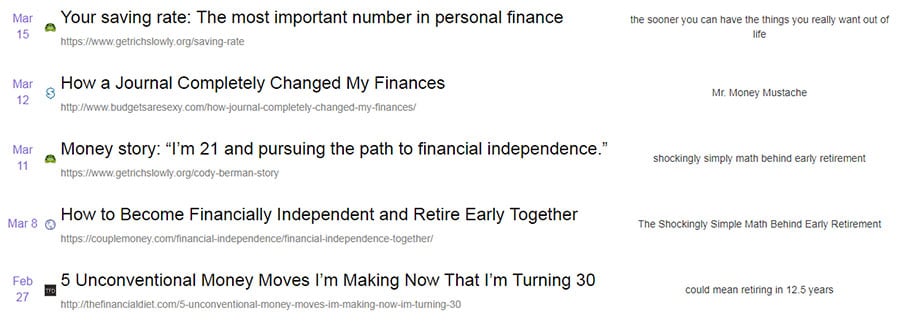
It seems like people found so much use in the article for their own personal journey that they have no problems making sure their readers get to learn from it as well.
Be clear about a significant goal most of your audience have, and either map out a way to get there from your own experience, or share insights you’re picking up along your own journey.
Rank Your Niche: It’s Not Just the Sites Included Who Will Link Back
Published: January 27th, 2014 | Notable link: Blogdash.com (February 26th, 2018)

It pains me to link to this because we’re trying to rank our own list of the top finance blogs but maybe the link karma gods will look down on Detailed kindly.
Modest Money’s own list of the top blogs in the finance niche has picked up, by far, more links than anything else in the finance world so far in 2018.
I think this is clear example of “snowball link building”, where you continue to pick up links because you already rank for something.
People aren’t linking to this because of any kind of special relationship they have with the site (at least not recently), but because it’s an easy way to say ‘here are some top personal finance blogs’.
For instance, just last week it was linked to by the Wall Street Survivor blog with the anchor text, “Digest as much information as you can from the top financial blogs on personal finance and ensure”.
The text in italic made up the clickable link.
BlogDash linked with similar anchor text, “the best financial blogs and money saving tips”.
They’re not saying it was great to be included (as neither of them are). They’re just sharing a valuable resource so they can get on with the rest of their article.
If there isn’t yet someone who has ranked your niche, here’s your motivation.
Influencers Will Link to Events They’re Involved In
Published: February 12th, 2018 | Notable link: AngelinaTravels.BoardingArea.com (February 12th, 2018)

I can’t think of a better way to entice people to link to something than when they’re personally involved in it.
Okay, maybe I can: Use someone’s product or service and have massive success with it and they will link to your story a million times over (but let’s leave that for another blog post).
Speakers for an upcoming travel conference, Frequent Traveler University (or FTU), were more than happy to announce that tickets were now on sale and you would be able to personally meet them at the event.
Here’s popular blogger Angelina Travels doing just that.

Lots of blog posts were written solely about the conference, with headlines including:
- Flash Sale: Save on Upcoming FT Events
- Come See Me at FTU This Summer
- FTU Coming to NYC & DC: Get $200 Off Tickets
- New FTU Events Announced!
- Learn Everything About Points and Miles at FTU
I shortened the headlines to make them easier to read (changing Frequent Traveler University to FTU), but didn’t add any words.
Speaking at an event helps raise someone’s profile – you get to take pictures of yourself holding a microphone on stage, after all – so if you your industry needs one more conference, consider being the one to host it.
If you’re not interested in offline marketing, I have seen people have success running virtual summits as well, but their speakers don’t tend to write entire blog posts about them.
The Free Email Course That the Personal Finance World Sunk Their Links Into
Published: February 21st, 2018 | Notable link: 1500Days.com (March 13th, 2018)

It’s nice to see that early staples of content marketing can still get people talking.
Birds of a Fire set the finance world alight (I had to say it) when they released their free 18-day financial independence email course.
FIRE, a popular acronym in the finance blogging world, stands for Financial Independence Retire Early.
Finance bloggers are a close-knit community who cheer on each other’s progress so I’m not surprised to see this do well.
I would say the links it picked up were almost as much about who shared the email course than what they had created (people linking to it can’t have gone through it) but the concept itself has always done well online.
If nothing else, creating an email course is a great way to get people on your email list who may not have been enticed to join it before.
Share Industry Numbers That People Can Build Off and Quote
Published: January 22nd, 2018 | Notable link: Usabilia.com (January 24th, 2018)

Towards the end of January, email automation platform Mailchimp released their annual stats on how many emails were being sent out using their service.
This particular update was focused on the shopping holiday Black Friday, with their customers sending over 1.9 billion emails.
As some MailChimp users integrate the service directly with their online stores, they were able to attribute those emails to over $6bn in sales, compared to $3.5bn in 2016.
So who’s linking to this kind of content?
Medium publication UX Collective used the stats to help justify an article on why every startup needs a blog. They specifically focused on how beautiful the article was that shared all of the data.
Usabilia used the data when opening up a public discussion on how other people’s holiday results shaped up, as you can see in the screenshot below.

Other’s simply included it in roundups of ‘cool stuff to click on.’
If you have any kind of unique data you can give out to share the progression of something in your space (more emails, more sales, more [something]), then you may find people latch on to that and cover it in their own way.
A Scoop is a Scoop, Even When Nobody Reads Your Site for That Particular Topic
Published: February 22nd, 2018 | Notable link: Coindesk.com (February 22nd, 2018)

Al-Monitor, which describes itself as “the pulse of the middle east”, is known for their reporting on places like Egypt, Iran, Iraq and Israel.
When they published the scoop that one of the countries they frequently cover (Turkey) is considering their own ‘national’ bitcoin, cryptocurrency blogs covered it in droves.
There isn’t much I need to say about this angle: If you can report a story first, people will link to you.
News sites publish so much content that as a by-product of their reporting, someone with a blog will find something they write interesting.
This stood out to me though because it provided the ‘meat’ for others to write entire article around, like Coindesk shown below.

Coindesk consistently rank in the top three cryptocurrency blogs online, reaching tens of millions of monthly visitors.
Getting mentioned by a big site like this can (and did) encourage a few smaller sites to report the news as well.
I have never had a scoop in my life so I’m not going to advise you on how to get them, but if you ever have the (ethical) opportunity to write about something first, take it.
Share Your Knowledge, Especially If It Deviates From the Norm
Published: March 7th, 2018 | Notable link: NovelInvestor.com (March 9th, 2018)

The Collaborative fund, which manages over $150m, is an alliance of nine individual investors.
One of those investors, Morgan Housel, published an insights-packed article on the ideas he believes changed his life.
I think the article was so popular because he makes some points you may not immediately agree with or have thought about.
The first section is based around the idea that “Everyone belongs to a tribe and underestimates how influential that tribe is on their thinking.”
Maybe you’ve never thought of this concept and it makes sense to you. Either way, it grabs your attention because it’s not the kind of thing you hear every day.
Here’s just a snapshot of the links it picked up (our private link index is not as pretty as the public one).

Four of the many links the article picked up in March were from link roundups, meaning the piece didn’t necessarily fit into articles that people were writing, but when they were in the mood to link out, they kept this one in mind.
Can you take a stand? Make a point? Share your personal experiences?
If they’re uncommon, they might just get people talking.
A Picture Contest Is Worth 1,000 Links
Published: February 14th, 2018 | Notable link: TheAtlantic.com (February 15th, 2018)

World Press Photo, a non-profit organisation, recently unveiled the nominations for the world press photo of the year.
As the name suggests, the best pictures by photo journalists are shared on the site before the winners are announced at an in-person event.
Unsurprisingly, because of the calibre of the work involved, photography blogs were quick to pick up the story.
While you may not be in the photography niche, you can certainly highlight the best work that others in your industry have created.
I actually think this is one of the best opportunities in this entire article because while contests are common, they tend to be about winning something rather than showcasing the best of an industry in one place.
I love the idea of building a minisite just to celebrate those who are doing the greatest things in your field.
Industry Stats Created Another Six-Year-Old Article That Top Blogs Can’t Stop Quoting
Published: May 28th, 2012 | Notable link: SEMRush.com (January 12th, 2018)
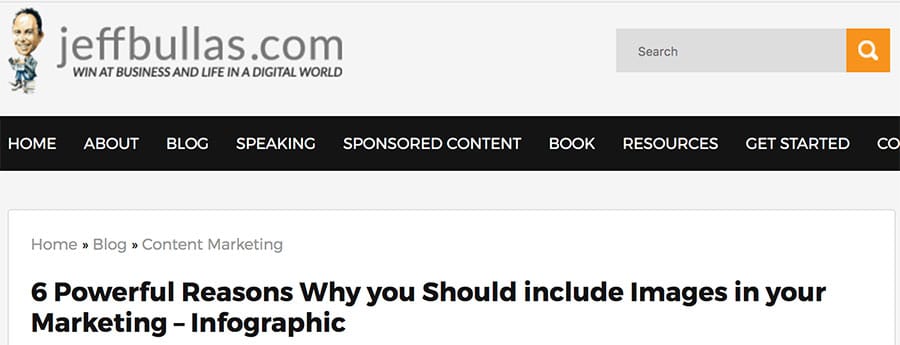
If you’re active in the marketing world, you may already be familiar with the blog of Jeff Bullas.
What you might not know is that Jeff published a piece of research six years ago (!) that still picks up links from some of the most popular marketing blogs.
What’s even more interesting to me is that the anchor text people use to link to his article is almost entirely the same.
Here’s the anchor text of five links the article picked up in March of this year:
- Increase views by 94%
- relevant images
- 94% more views
- use relevant and compelling images
- relevant images
It’s funny to see that two separate sites (SEMRush and Customer Think) both wanted to highlight the same stat about the importance of using images in your articles.
Interestingly, the stats people are linking to were created by an entirely different company and Jeff’s article is only 655 words with their infographic in the middle.
People link to this because they want to make a point in their article without having to cover it in too much depth.
It’s much easier to simply link to someone else’s research and insights on the topic, and I’m sure Jeff isn’t complaining.
How do they find it to link to? I would put that once again down to snowball link building — picking up links because you already rank.
It’s second in Google for ‘importance of images’ along with 2,000 other related keyphrases.
Curating the Research of Others Works Surprisingly Well
Published: April 4th, 2011 | Notable link: Stripe.com (March 23rd, 2018)

When our link index outputted the URL for this page my first thought was “Makes sense they’re getting links. They put together some stats.”
Look at the URL to see what I mean: https://baymard.com/lists/cart-abandonment-rate
You just assume from the text in the link that they’ve done their own research on cart abandonment rate, but that wouldn’t be entirely correct.
The lists part of the URL is a bit more of a giveaway: Baymard Institute have put together a resource of the best cart abandonment research by other people.
They do include some comments of their own, but they only make up 300 words.
CrazyEgg, BPlans, Foundr and Campaign Monitor are among dozens of sites who have linked back to the curated resource in 2018.
Why?
My theory is once again because it ranks so well in Google. They’re literally #1 for ‘cart abandonment statistics’ and ‘cart abandonment rate’.
If you just want to throw a quick link in an article, take the first result and call it a day.
Of course, they had to create something valuable to get those links in the first place, and as a curated list of the research of others, it’s nice to think everyone is enjoying some traffic.
Stories Are Incredibly Powerful (Even When They’re Not True)
Published: May 14th, 2015 | Notable link: StartupBeat.com (March 22nd, 2018)

It makes for a great headline: Goldfish have a longer attention span than humans.
If I hadn’t clicked on a random YouTube video a few weeks ago I would have followed the rest of the internet in finding the stats sad but totally believable.
That random video was from LinkedIn’s head of marketing who went down the rabbit hole trying to find the true source for this data, but it doesn’t appear to exist.
The BBC corroborated his findings with their own research.
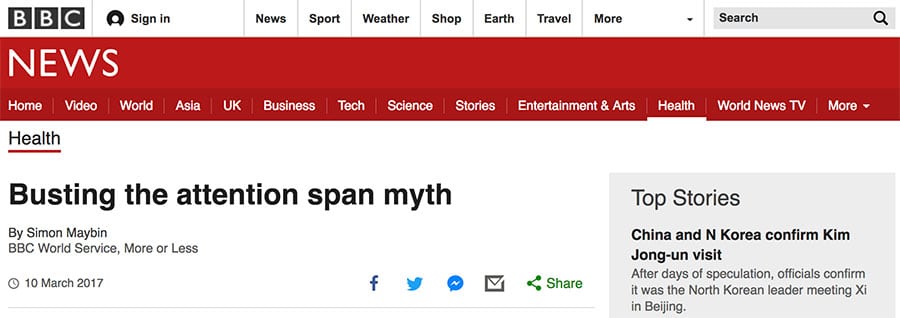
As the saying goes, a lie can travel half way around the world before the truth gets a chance to put its shoes on.
This isn’t a lie per say, but shows that facts can get in the way of a good story.
Just look at how many links it is still picking up, three years after it was first published.
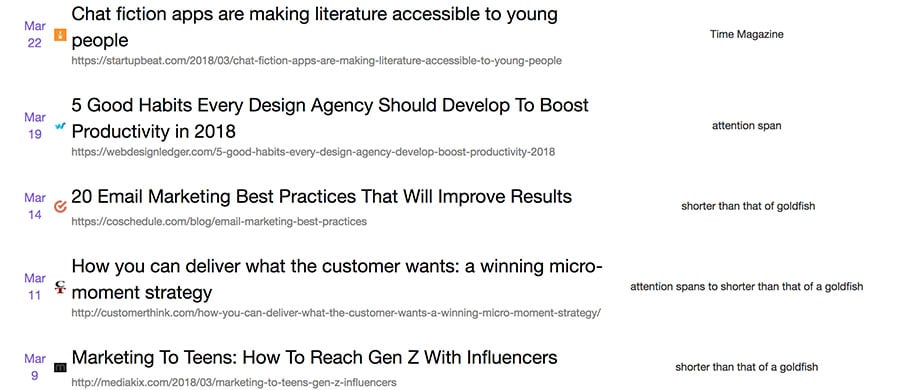
With the anchor text people are using, it’s clear they just want to make a point – “You / your readers have a short attention span.” – without really having to explain why they’re saying it.
PDF Research Reports (Even Old Ones) Appeal to the Linkerati
Published: September, 2015 | Notable link: QuickSprout.com (February 19th, 2018)

If you’ve been involved in content marketing for any length of time then you have likely heard of Joe Pulizzi’s Content Marketing Institute.
Joe sold the company a few years ago for $17m so it’s fair to say he knows how to use content to promote his work.
In recent years Content Marketing Institute put out reports sharing survey results on the topic of B2B Content Marketing.
What’s surprising is that in 2018, the 2016 version of the report has picked up more links than the 2017 version.
Let me say that again so it’s less confusing. This year, more people are linking to the 2016 report that Joe put together on this subject than the most recent version (the 2017 edition).
Atomic Reach wrote about ‘Content Marketing Trends for 2018’ yet still linked to data from a few years ago.

It could be that few people know the 2017 version exists, but it’s interesting they’re still happy to link to what might appear as more ‘dated’ stats.
It’s also interesting that people have no problems linking directly to PDF reports (which both versions are). I think Joe is missing a trick when it comes to not having the data accessible on a blog post, but I’ve never sold a company for $17m, so what do I know.
Nostalgia is a Powerful Emotion If You’re Looking for Reactions
Published: January 31st, 2018 | Notable link: Eatfeastly.com (February 16th, 2018)

Until I put this article together, I had never heard of Carob.
I had to read this piece by the New Yorker to have any idea that it was actually supposed to be some kind of chocolate substitute ‘back in the day’.
A number of food bloggers were happy to share the trip down memory lane with their readers.
Eat Feastly talked about the story in their “What we’re reading this week” while Joy the Baker included it in her link round ups which happen every Sunday.
We often see nostalgia work well in places like Reddit or image sharing communities like 9Gag, but I haven’t seen it used too often in written content.
Maybe it’s time to change that.
Revisting History Works For Those Incredibly Passionate About Their Niche
Published: February 13th, 2018 | Notable link: LongReads.com (February 16th, 2018)

Another article that got food bloggers talking this year was The New York Times’ history lesson on the discovery of hill rice.
Like Carob, it’s not something I’ve ever heard of.
This too picked up links from roundups by Eat Feastly and Joy the Baker (though not in the same week).
Longreads, which reaches an estimated one million visitors per month, dedicated an entire article to the piece.
They used the headline “The Unexpected Reemergence of an Elusive Strain of Rice” to add their commentary.

It shouldn’t be surprising that the New Yorker or The New York Times pick up links – so much so that I was tempted not to include them in this article.
That said, as they both had unique angles with their content, I thought I would make an exception and include them.
I’ve seen articles on history work particularly well in the fitness niche (talking about the old greats) and in the programming world (how things got started) so I’ll make sure I dedicate an entire article to this ‘tactic’ in the near future.
10X Content: A Real-World Example of Taking a Concept to the Next Level
Published: November 27th, 2013 | Notable link: Stripe.com (March 23rd, 2018)

Joint first on our list with the most links from various sites, Hubspot’s incredible marketing statistics page will not leave you wondering why people talk about it.
The page is practically a goldmine for picking up links as people get to use it to back up points they make in their articles about a variety of topics.
In February & March alone (not including January as the list will get too long) it picked up links from sites like:
- KissMetrics
- Godaddy
- OptinMonster
- MarketingProfs
- Neil Patel
- 60 Second Marketer
- Ninja Outreach
Now we can add Detailed to that list as well.
Of course, we could say that HubSpot are a huge brand so that helps them pick up these types of links, but I say it’s this type of content that helped them become a huge brand.
You likely know how well having unique stats can work when it comes to people using your data to make a point, but Hubspot really went above and beyond with this article.
It’s a great example of taking a proven angle and then just taking it to the next level.
Create a Free Tool, Because Every Blog Has a ‘Best Tools for X’ Roundup Post
Published: April 2nd, 2013 | Notable link: CoSchedule.com (March 12th, 2018)

We love free things.
We especially like people sharing useful free things with us that we didn’t previously know about.
That could be why people are more than happy to continually recommend Hemingway Editor, five years after it launched.
The software works in a web browser (and on desktop if you so choose) and highlights sections of your writing where your wording can be improved.
While it picked up links for a variety of reasons, some of the most common headlines are around tool roundups, such as:
- 20 Best Free Email Marketing Tools and Resources (HongKiat)
- 9 Essential Online Writing Tools to Help Improve Your Content (Search Engine Journal)
- The 11 Best Free Email Marketing Tools (Sprout Social)
- 100+ Blogging Tools For 2018, Categorized (Shout Me Loud)
I’ve already found that with the relaunch of Detailed, people are starting to include the site in roundups of tools where you can check backlinks, which I think is really cool.
If you have some programming skills, or a budget of a few hundred bucks for something simple, then don’t under estimate how valuable free software can be when it comes to people sharing things.
In the Right Niche, Rumors Are As Linkworthy as Facts
Published: January 11th, 2018 | Notable link: Petapixel.com (January 16th, 2018)
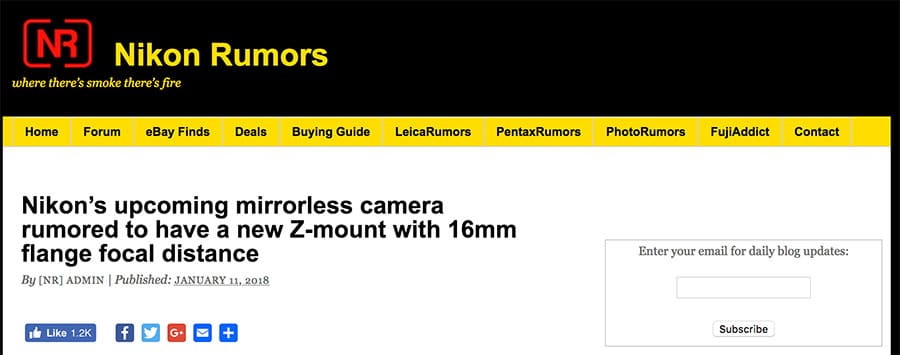
I have an upcoming post planned to talk about how powerful scoops can be, but I’m sure it’s no surprise to you that if you’re the first to report a story, you can get a lot of attention.
What you might not know is that the scoop doesn’t have to be factual.
Take Nikon Rumors’ recent post in the photography niche (scoops are kind of their thing) when they talked about Nikon’s rumoured upcoming mirrorless camera.
The story quickly picked up links from Petapixel (the number one site in the photography niche), Phoblographer, DPReview and Fstoppers, among others.
![]()
Every single one of these sites wrote an entire story about the original Nikon Rumors scoop.
Though scoops aren’t easy to get, I do want to show you what works, and they’re possibly the best way to pick up links if you can land them.
In-depth Comparisons: For When Opinion is More Important Than Data
Published: January 6th, 2018 | Notable link: SLRLounge.com (February 21st, 2018)

William Edwards Deming made two frequently quoted remarks about data.
In God we trust; all others must bring data.
And,
Without data you’re just another person with an opinion.
With everything we’ve ever done here at Detailed being data-focused, you could say I’m a fan of his message.
That said, there are times when feelings and opinions need to take precedent.
When you’re going to spend hundreds or even thousands of dollars on a piece of technology, you really want to see how well it fares against the competition, rather than just relying on what the manufacturer tells you.
What better idea to test expensive hardware in an environment that might render it useless: Bad weather.
Imaging Resource published an in-depth weather test where they compared top-of-the-line Nikon, Canon, Olympus and Sony cameras in unfavorable conditions.
The post, which went live on the 6th of January this year, comprised of images, videos and thousands of words of text.
It clearly hit a mark with their audience, receiving over 200 comments – a rarity in the age of feedback via social media.
As you can imagine from the tone of this post, they picked up a number of links from other big sites in the photography space, showing the power of this kind of comparison.
Side Projects That Solve a Real Problem. Meet Colloq
Published: June 3rd, 2017 | Notable link: SmashingMagazine.com (March 16th, 2018)

I’m not sure if it’s entirely accurate to call Colloq a side project, but it was started recently and isn’t the main focus of its founders, so I think that’s at least a fair way to define it.
This simple project that helps you find conferences in different topics and in different events, primarily targeted towards designers and developers.
I don’t attend any conferences so Colloq certainly isn’t aimed at me, but with how many conferences there are in the digital marketing world alone, I can see how valuable their offering will be.
With the number of sites starting to talk about them, I’m certainly not the only one who sees merit in the idea.
As you would expect, design & development sites are the ones talking about it the most (below), but they’re not the only ones.

Though many of their links have been picked up through guest posts, they are earning natural mentions around the web, which I’m sure will continue as the service becomes more popular.
The truth is that I could have written about 100+ side projects that are still picking up links in 2018, but I wanted to highlight something fairly new (less than a year old) with an interesting angle.
Websites that solve a need and are both stylish and functional will always attract backlinks.
Create a Framework That Others Can Follow
Published: June 10th, 2013 | Notable link: SmashingMagazine.com (March 15th, 2018)

Five years ago, developer Brad Frost introduced a concept called ‘atomic design’ to the world via this blog post.
I consider myself to be a very slightly above average web designer but I still don’t really get why the article is so popular.
I get the concept, but it has been five years since it was published and it’s still picking up links from Smashing Magazine, Drupal, Invision App and others.
These are among the biggest sites in the design and development world (Smashing Magazine is literally number #1 in our blog rankings).
It could be because of the tool the post links to – which helps you build websites using the framework – but I can’t quite figure it out.
Still, it is one of many pieces of content like this that I’ve seen do well.
Give people an overarching view of a subject and then break it down, point by point, so that they can see how each part fits together.
When people are writing about your topic and don’t want to go into detail on the “basics”, there’s a chance they’ll send people your way.
Put Out Data That Let’s Other People Look Smart
Published: March 8th, 2018 | Notable link: ConvinceandConvert.com (March 10th, 2018)

When a New York Times best-selling author writes an entire article about a small part of your data you probably have a good thing on your hands.
Each year, Edison Research puts out what they call the ‘Infinite Dial Report’, which asks people various questions about the modern technology they use in their lives.
As they stick to the same questions every year, it makes each update even more valuable because you can compare changing usage over time.
For instance, they were able to report that in 2017, podcast listening among American women jumped 14%.
Jay Baer, the bestselling author I mentioned, put this data into an article on ‘The 13 Podcast Critical Statistics of 2018’.

The Edison Research is interesting, but their design leaves a lot to be desired.
I actually wonder if the data being formatted in the way it is could be their benefit: People repurpose and pick apart the data in an easier to digest manner, but link back to the original source out of courtesy and respect.
Survey Your Niche And Share the Results: Lessons from StackOverflow
Published: March 13th, 2018 / Notable link: Entire article on WPTavern.com

This next example shouldn’t be too surprising to any developer who saw this go viral on Twitter in the past fortnight, but it’s a great example of the power of questioning your audience.
Stack Overflow recently put out their 2018 developer survey results which delve into things like the professional developers’ preferred coding language, salaries around the world and the number of dev’s employed in-house versus those working remotely.
Entire articles from other sites were written about the survey, with WPTavern, a WordPress focused blog, originally headlining theirs as “Stack Overflow Survey Respondents Still Rank WordPress Among the Most Dreadful Platforms.”
Interestingly they changed the title before I managed to take this screenshot.

What we’re seeing here is that survey results aren’t just interesting to the people directly involved in them (developers), but people can (and will) take that data and see how the results can be of interest to their own audience.
Of course, it helps that Stack Overflow is a big brand in the design & development world, there far from being the only ones with a big enough reach to put something like this together.
I’ve recently been heavily involved in creating surveys for clients and while it can take work to get people to respond to them, having original data to share is priceless.
“Cool” Stuff Still Works; Just Don’t Turn into Bored Panda
Published: February 24th, 2018 | Notable link: UltraRunnerPodcast.com (February 26th, 2018)
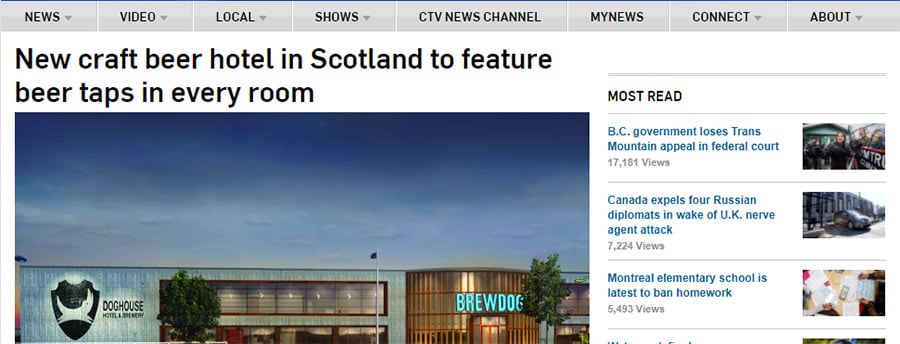
I wouldn’t expect trying to become the next Viral Nova or Bored Panda will pick up many links, but I couldn’t not include an example that is a little out of the norm.
When a news website featured a new hotels’ unique selling point, people loved the idea.
You certainly can’t predict how well “cool” news will be received (not every Bored Panda article is a hit) but there is a chance people will take the information and share it in their own unique way.
For instance, the Ultra Runner podcast linked to this article with the anchor text,
“It looks like they’ve found a venue for the inaugural ultra trail Scotland.”
I’m not sure about you but I thought that was pretty funny.
I wouldn’t be surprised if hundreds or thousands of people have read the article, sent it to their friends and said “We need to go here.”
The Ultra Runner Podcast are sharing that same message in blogging form.
I would use this sparingly, and keep in mind you have to reach a lot of people to pick up links, but there might just be the perfect story to share you can see your audience enjoying.
Take Complex Research And Explain the Results in Laymans Terms
Published: February 20th, 2018 | Notable link: FoodPolitics.com (February 28th, 2018)
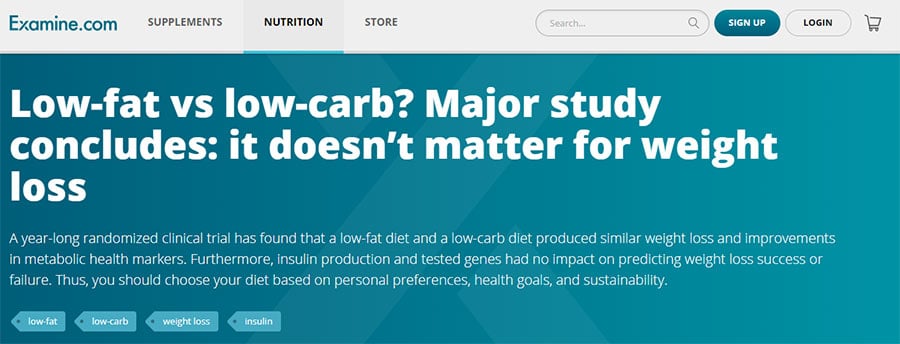
As I was getting ready to publish this article, I realised I had picked 24 examples to discuss.
To cure my headline OCD I knew I had to find one more angle to cover.
Fortunately, the team at Examine.com recently put together a great article on whether you should eat low fat or low carbs to lose weight.
Their article discussed a recent scientific study from Dr. Christopher Gardner of Stanford University.
If you aren’t subscribed to email lists or websites which share diet studies however, there’s a good chance that you a) would have missed the information in the first place or b) not had the interest to go looking for the nuggets of knowledge in all of the research.
That’s where Examine came in, with an article that breaks down what the research shows, and what it does not, in ways that anyone can understand.
This resulted in a lot of sites in the fitness and health space linking to them.

Guess what?
Out of the six links in the screenshot above, only three linked back to the original source. The other three only linked to the commentary on Examine.
I understand you may not be in the health space where opportunities like this will crop up more often, but they do exist.
The Infinite Dial example above certainly isn’t optimised for people to talk about.
Is there research in your niche that you could breakdown and dissect for others? If so, you might just get more attention than the original, or uncover some valuable insights people didn’t even know existed.
Create an In-Depth Review of the Most Anticipated Product in Your Space
Published: February 6th, 2018 | Notable link: TheWireCutter.com (February 14th, 2018)

I’ve put this last on our list because quite honestly, it might be the least valuable.
Out of the 25 angles shared here today, I think this is the most difficult to implement because you have to get your hands on a physical product that is either really interesting (that other people haven’t covered) or really anticipated (that other people haven’t covered).
That said, being the first to physical product reviews has made some business owners multi-millionaires (e.g. iFixIt with their Apple teardowns) so there is a huge market for reviews.
On the 6th of February, tech blog The Verge went live with their review of Apple’s latest device, the Homepod.
As you can imagine this picked up links from other sites in the tech sphere, but that wasn’t all.
Certainly helped by the huge reach The Verge has and their reputation for in-depth journalism, sites like Abnormal Returns (an investment blog) and Hubspot (a marketing software provider) both included the review in their weekly link roundups.

I’m not too surprised – anything Apple related tends to get the world’s interest – but it’s another example of being the first to cover something, or at least the first to certain people.
The other thing that makes this angle particularly difficult is that The Verge went to a ton of effort in this review. Their video at the top of the article is so polished that it looks like Apple themselves put it together.
A Simple Tip to Know If What You’re Creating Will Hit the Mark
There are certainly more angles than the 25 I’ve shared here, but I hope you found some inspiration in this article.
A good thing to keep in mind when you’re creating content that will hopefully attract links is to ask yourself, “If somebody else shared this, would people thank them for it?“.
Would their audience be grateful to read my product review? My industry stats? My trip down nostalgia lane?
If what you create is so good that the person sharing it looks better for doing so, then you’re probably on to a winner.






